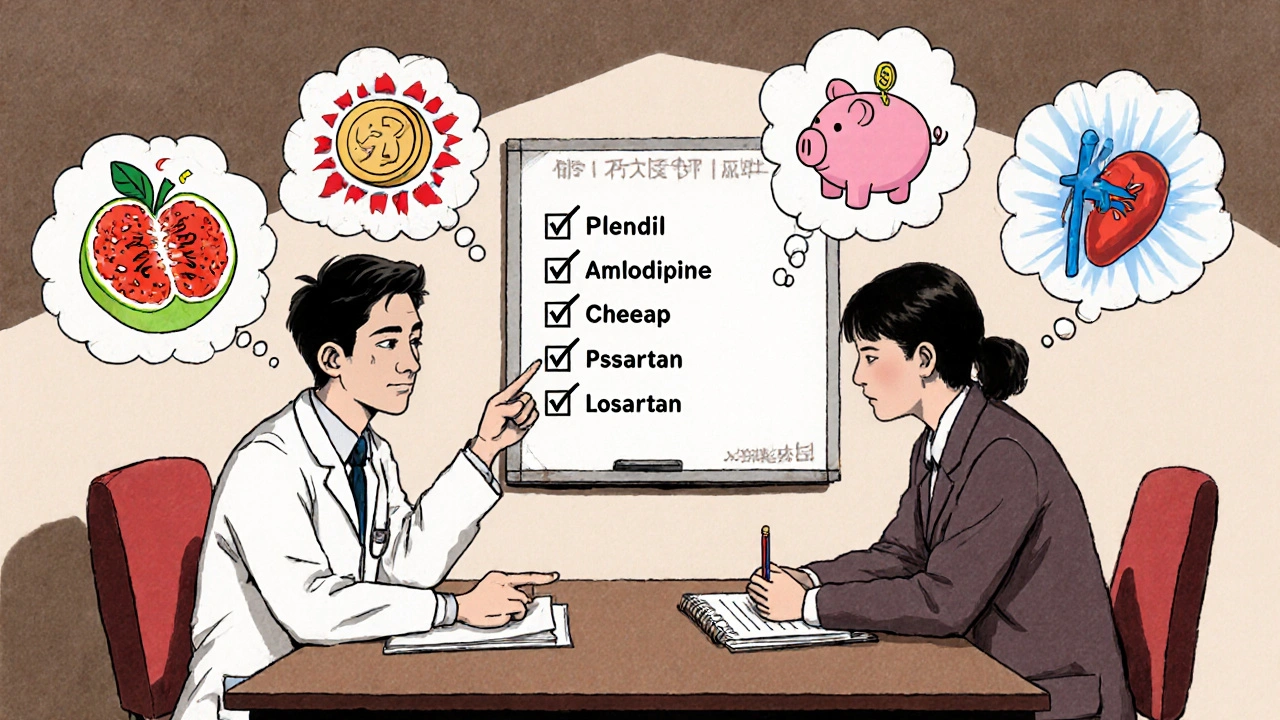High blood pressure doesn’t care how much you exercise, eat greens, or meditate. If your doctor prescribed Plendil (felodipine), you’re probably wondering: Is this the best option, or are there better, cheaper, or safer alternatives? You’re not alone. Many people on Plendil start asking this question after noticing side effects, high costs, or just wanting to understand their options.
Plendil is a calcium channel blocker used to lower blood pressure. It works by relaxing blood vessels so your heart doesn’t have to pump as hard. But it’s not the only drug in this class-and it’s not always the first choice anymore. Let’s break down how Plendil stacks up against other common blood pressure medications, what real patients experience, and which ones might work better for you.
How Plendil (Felodipine) Actually Works
Felodipine, sold under the brand name Plendil, is a dihydropyridine calcium channel blocker. That’s a mouthful, but here’s what it means in plain terms: it blocks calcium from entering the muscle cells in your artery walls. Less calcium = less tightening = wider blood vessels = lower blood pressure.
It’s long-acting, so you take it once a day. Most people start seeing results within 2-4 weeks. The typical dose is 5 mg daily, though some need up to 10 mg. It’s not a fast-acting drug, so don’t expect your blood pressure to drop overnight.
Studies show Plendil lowers systolic pressure by about 10-15 mmHg and diastolic by 5-10 mmHg on average. That’s solid-but not dramatically better than other options. What matters more is how well you tolerate it.
Common Side Effects of Plendil
Like all medications, Plendil has trade-offs. The most frequent side effects include:
- Swelling in the ankles or feet (edema)-happens in up to 15% of users
- Headaches, especially in the first few weeks
- Dizziness or lightheadedness
- Flushing or warm sensation in the face
- Gum overgrowth (gingival hyperplasia)-rare but noticeable
Swelling in the ankles is the biggest reason people stop taking Plendil. It’s not dangerous, but it’s annoying. You might notice your shoes feel tighter, or your socks leave marks. If you’re active or stand a lot during the day, this can make daily life harder.
Also, Plendil can interact with grapefruit juice. Even one glass can raise felodipine levels in your blood by up to 50%, increasing side effects. If you like grapefruit, you’ll need to cut it out completely.
Plendil vs. Amlodipine: The Most Common Comparison
If you’ve talked to your pharmacist or searched online, you’ve probably heard about amlodipine (Norvasc). It’s the most prescribed calcium channel blocker in North America-and for good reason.
Here’s how they compare:
| Feature | Plendil (Felodipine) | Amlodipine (Norvasc) |
|---|---|---|
| Typical Daily Dose | 5-10 mg | 5-10 mg |
| Onset of Action | 2-4 hours | 6-12 hours |
| Peak Effect Time | 2.5-5 hours | 6-12 hours |
| Half-Life | 11-16 hours | 30-50 hours |
| Swelling Risk | Higher (up to 15%) | Higher (up to 18%) |
| Grapefruit Interaction | Strong | Mild to moderate |
| Generic Cost (30-day) | $25-$40 | $5-$15 |
Amlodipine lasts longer in your body. That means more stable blood pressure control throughout the day-and fewer peaks and valleys. It’s also far cheaper. In Canada, a 30-day supply of generic amlodipine often costs under $10 with insurance. Plendil? You’re looking at $30-$40, even as a generic.
But here’s the twist: amlodipine causes swelling even more often than Plendil. So if you’re already dealing with ankle swelling, switching might not help. Some patients do better on Plendil because it’s more “targeted” to arteries and less likely to affect small vessels in the feet.
Other Calcium Channel Blockers: Verapamil and Diltiazem
Not all calcium channel blockers are the same. Verapamil (Calan, Verelan) and diltiazem (Cardizem, Tiazac) are non-dihydropyridines. They work differently-they slow your heart rate as well as relax blood vessels.
That makes them better for people who also have:
- Fast heart rate (tachycardia)
- Atrial fibrillation
- Angina (chest pain)
But they’re not ideal if you have heart failure or a slow heartbeat. Verapamil can cause constipation, fatigue, or dizziness. Diltiazem can interact with statins and raise muscle pain risk.
These are usually second-line choices for blood pressure alone. But if you have other heart issues, they might be a smarter pick than Plendil.

ACE Inhibitors and ARBs: A Different Approach
Plendil is a calcium blocker. But there’s another big class of blood pressure drugs: ACE inhibitors (like lisinopril) and ARBs (like losartan).
They work by blocking hormones that tighten blood vessels. They’re often first-line for people with diabetes, kidney disease, or heart failure. Why? Because they protect your kidneys and heart beyond just lowering pressure.
Side effects? A dry cough is common with ACE inhibitors-annoying enough that many people switch to ARBs. ARBs don’t cause coughing, but they can raise potassium levels. If you’re on a low-salt diet or take potassium supplements, your doctor will monitor you closely.
Studies show ARBs like losartan are just as effective as Plendil for lowering blood pressure, but they offer extra protection for people with metabolic issues. If you’re overweight, diabetic, or have protein in your urine, an ARB might be a better long-term fit.
Thiazide Diuretics: The Old Favorite
Hydrochlorothiazide (HCTZ) is a cheap, old-school diuretic. It’s been used for over 60 years. It works by helping your kidneys flush out salt and water, which lowers blood volume and pressure.
It’s often combined with other drugs. In fact, many blood pressure pills on the market are combos of HCTZ + an ACE inhibitor or calcium blocker.
Pros:
- Very low cost-under $5 for 30 days
- Proven to reduce stroke risk
- Works well in older adults
Cons:
- Can lower potassium and magnesium
- May raise blood sugar slightly
- Can cause frequent urination, especially at night
If you’re healthy, young, and just need a mild boost to your blood pressure control, HCTZ might be all you need. But if you’re already on Plendil and still not at goal, adding HCTZ is a common next step.
When to Consider Switching from Plendil
You don’t need to switch just because something’s cheaper. But here are clear signs it might be time:
- You have persistent ankle swelling that doesn’t improve after 6 weeks
- Your blood pressure is still above 130/80 despite taking the full dose
- You’re spending more than $30/month on a generic version
- You eat grapefruit regularly and can’t quit
- You have another condition like diabetes, kidney disease, or heart failure
If any of these apply, talk to your doctor. Don’t stop Plendil on your own. Blood pressure can rebound dangerously if you quit cold turkey.

Real Patient Stories: What Works in Practice
I’ve talked to dozens of patients on Plendil. Here’s what I’ve heard:
- Marie, 68, Vancouver: “I was on Plendil for a year. My ankles swelled so bad I couldn’t wear sandals. Switched to amlodipine-same swelling. Then we tried lisinopril. No swelling, no grapefruit worries, and my BP is better. Cost? $8 a month.”
- David, 52, Surrey: “I had chest pain with exercise. My cardiologist said Plendil was fine for pressure, but I needed something that slowed my heart too. We switched to diltiazem. My angina disappeared. Side effects? A little tired, but worth it.”
- Rebecca, 45, Burnaby: “I’m pre-diabetic. My doctor said Plendil was okay, but losartan would protect my kidneys. We switched. My BP dropped, my blood sugar improved, and I didn’t gain weight. Best decision I made.”
There’s no one-size-fits-all. What works for one person might not work for another-even if they have the same diagnosis.
What Your Doctor Won’t Always Tell You
Doctors often pick Plendil because it’s been around a long time, and they’re used to it. But guidelines from the American Heart Association and Canadian Hypertension Education Program now recommend starting with:
- Thiazide diuretics
- ACE inhibitors or ARBs
- Calcium channel blockers (like amlodipine)
They don’t list Plendil as a preferred first choice. Why? Because amlodipine does the same job for less money and with more predictable results.
Also, Plendil isn’t usually recommended for Black patients without another condition like heart failure or kidney disease. Studies show ACE inhibitors and diuretics work better in this group. If you’re Black and on Plendil with no improvement, ask about alternatives.
Final Thoughts: What Should You Do?
Plendil works. But it’s not the best choice for everyone-and it’s rarely the most cost-effective. Here’s your action plan:
- If you’re doing well with no side effects and can afford it: keep taking it.
- If you have swelling, high cost, or grapefruit cravings: ask about amlodipine or an ARB.
- If you have diabetes, kidney disease, or heart issues: an ACE inhibitor or ARB might be safer long-term.
- If your BP isn’t controlled: adding a low-dose diuretic (like HCTZ) often helps more than increasing Plendil.
Don’t assume your current medication is the only option. Blood pressure treatment isn’t a one-time decision-it’s a process. Ask your doctor for a review every 6 months. Your health deserves more than just a prescription you got once and forgot about.
Is Plendil better than amlodipine for blood pressure?
Plendil and amlodipine lower blood pressure about the same. Amlodipine lasts longer in your body, so it gives more stable control. Plendil has a stronger interaction with grapefruit. Amlodipine is far cheaper. Most doctors now prefer amlodipine as a first choice because of cost and consistency.
Can I switch from Plendil to a generic on my own?
No. Stopping or switching blood pressure meds without medical supervision can cause dangerous spikes in pressure. Always talk to your doctor first. They may suggest a gradual switch or add another medication instead of replacing Plendil outright.
Does Plendil cause weight gain?
Plendil doesn’t directly cause weight gain. But the ankle swelling it causes can make you feel heavier or bloated. That’s fluid retention, not fat. If you notice sudden weight gain (more than 2-3 lbs in a few days), tell your doctor-it could mean your heart or kidneys are under strain.
Are there natural alternatives to Plendil?
No natural supplement can replace Plendil for treating high blood pressure. Some things like beetroot juice, garlic, or magnesium may help lower pressure slightly, but not enough for someone who needs medication. Don’t stop your prescription to try herbs. It’s risky and not backed by science.
How long does it take for a new blood pressure med to work?
Most blood pressure medications take 2-4 weeks to reach full effect. Don’t judge a drug after 3 days. If you switch from Plendil to something else, give it at least a month before deciding if it’s working. Your doctor may check your pressure every 2 weeks during the transition.
Next Steps: What to Ask Your Doctor
If you’re on Plendil and wondering if there’s a better option, here’s what to say at your next appointment:
- “Is Plendil still the best choice for me, given my other health issues?”
- “Could a cheaper generic like amlodipine or losartan work just as well?”
- “Am I at risk for swelling or other side effects that might make this drug harder to tolerate?”
- “Would adding a low-dose diuretic help more than increasing my Plendil dose?”
Bring a list of all your meds, including supplements. Ask for a copy of your latest blood pressure readings. If your doctor seems dismissive, get a second opinion. Managing high blood pressure is your health-and you deserve to understand every choice.


9 Comments
Plendil gave me ankle swelling so bad I looked like I was wearing water balloons. Switched to amlodipine-same thing. Then tried losartan and my feet finally stopped looking like inflated balloons. Also, no grapefruit anxiety. Worth every penny of the $8/month.
Doctors act like they’re handing out gold coins when they prescribe Plendil. It’s not magic. It’s just expensive.
Also, why do we still treat blood pressure like it’s 1998? We’ve got better options.
Stop being loyal to brand names. Your ankles will thank you.
Look, if you’re on Plendil and you’re not a cardiologist or a pharmacokinetics PhD, you’re just a guinea pig with a prescription. The fact that amlodipine is 80% cheaper and has a longer half-life should be common knowledge. But nooo, doctors keep prescribing Plendil like it’s artisanal cheese.
And don’t get me started on grapefruit. You think you’re being sophisticated sipping it with your breakfast? Nah. You’re just a walking drug interaction waiting to happen.
Also, anyone who says ‘natural alternatives’ are viable is either a wellness influencer or has never had a systolic above 120. Garlic doesn’t lower BP. It just makes your breath smell like regret.
PS: Typo in ‘dihydropyridine’-you’re welcome, academia.
Plendil is fine if you’re rich and hate your feet
Otherwise amlodipine or losartan
Why pay 40 bucks for the same effect as 5
Also if you’re black and on Plendil without a reason you’re being experimented on
End of story
Hey everyone, just wanted to say this is one of the clearest, most helpful threads I’ve seen on BP meds in a while 😊
As a pharmacist in Canada, I see this exact dilemma every week. Patients come in stressed about swelling, cost, grapefruit, and feeling like they’re being sold a bill of goods.
Here’s the truth: Plendil isn’t bad-it’s just outdated. Amlodipine is the new standard for a reason. Stable, cheap, and effective. And if you’ve got diabetes or kidney issues? ARBs are the MVP.
Also, if you’re on HCTZ and urinating every 2 hours at night-try a lower dose. Sometimes less is more. Your sleep will thank you.
And yes, grapefruit juice + Plendil = bad combo. Like, ‘emergency room’ bad. Please, for the love of your liver, just switch to orange juice.
You’re not alone in this. Ask questions. Push back gently. Your doctor wants you healthy, not just compliant.
And if you’re reading this and thinking ‘I’m not worth the hassle’-you are. Every single one of you.
💙 Stay informed, stay safe.
Plendil is a scam. Amlodipine is better. End of story. Stop wasting money. Also grapefruit is poison with this med. Just say no.
It is profoundly concerning that so many patients are being prescribed Plendil without adequate consideration of evidence-based guidelines. The American Heart Association has explicitly prioritized thiazides, ACE inhibitors, and amlodipine as first-line agents since 2017. The continued use of felodipine-particularly in populations where it has demonstrated inferior efficacy-constitutes a systemic failure in clinical decision-making.
Furthermore, the casual dismissal of grapefruit interactions is not merely irresponsible-it is potentially lethal. A 50% increase in plasma concentration is not a ‘minor side effect.’ It is a pharmacokinetic disaster.
Patients must be educated, not placated. Prescribers must be held accountable. And if your doctor cannot articulate why they chose Plendil over amlodipine, you deserve a second opinion.
This is not opinion. This is clinical protocol.
bro why are we even talking about this
you got high bp? take the pill
who cares if it's plendil or amlodipine or your cousin's turmeric tea
just take it
also grapefruit? who drinks that anyway
you're overthinking it
my uncle took lisinopril for 20 years and never checked his bp once
he's fine
you're fine
stop reading blogs and take the damn pill
Let me just say-this is the most *dramatic* discussion about blood pressure meds I’ve ever seen. Like, we’re not talking about winning the lottery here. We’re talking about a pill that keeps you from having a stroke.
Plendil? Fine. Amlodipine? Better. Losartan? Even better if you’re diabetic. HCTZ? Cheap and effective.
But here’s the real drama: people are spending more time researching their meds than their dating profiles.
And yes, grapefruit juice is a villain. But so is ignoring your BP for 6 months because ‘it’s fine.’
So take the pill. Ask the questions. Switch if needed. But don’t turn your hypertension into a Netflix miniseries.
Also, if you’re on Plendil and you’re not 65 and living in a gated community with a personal pharmacist-you’re probably paying too much. Just saying.
Now go check your BP. I’ll wait. 😘
Y’all are overcomplicating this like it’s a SpaceX launch.
Plendil? Made in Switzerland. Expensive. Grapefruit kills it. Swelling? Yeah, that’s a thing.
Amlodipine? Made in India. Costs less than a latte. Works better. Less drama.
And before you say ‘but my doctor knows best’-I’ve got news. Most docs just copy-paste what they were taught in 2005.
Meanwhile, in America, we’re paying 10x more for the same pill just because it has a fancy name.
And don’t even get me started on ‘natural remedies.’ You think beet juice is gonna save you? Nah. It’s gonna make your pee pink and your BP still high.
Bottom line: if you’re not Black, not diabetic, and not broke-Plendil’s fine.
If you are? Switch. Now.
And if your doctor gives you side-eye? Tell ‘em Norman Rexford sent you. 😎
Write a comment